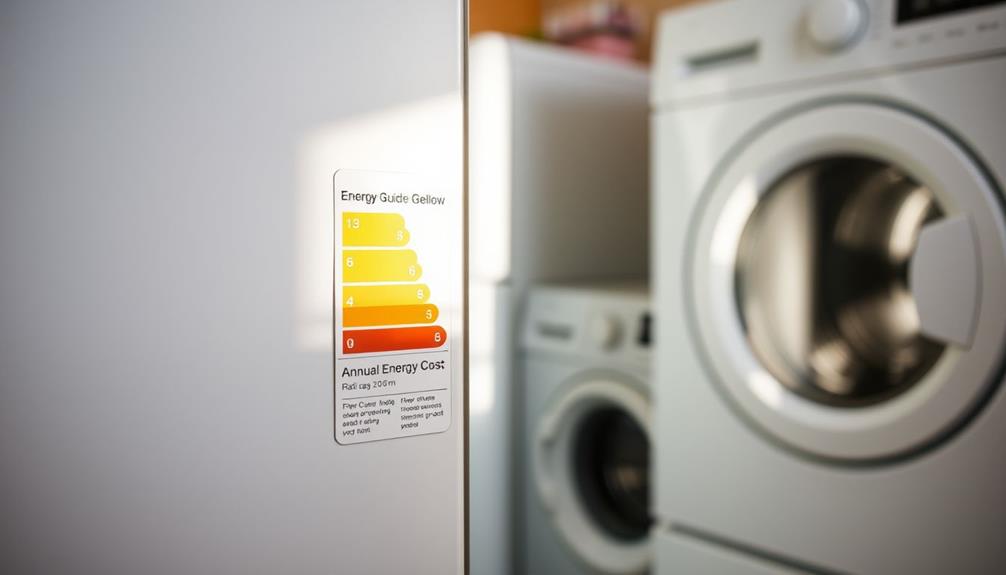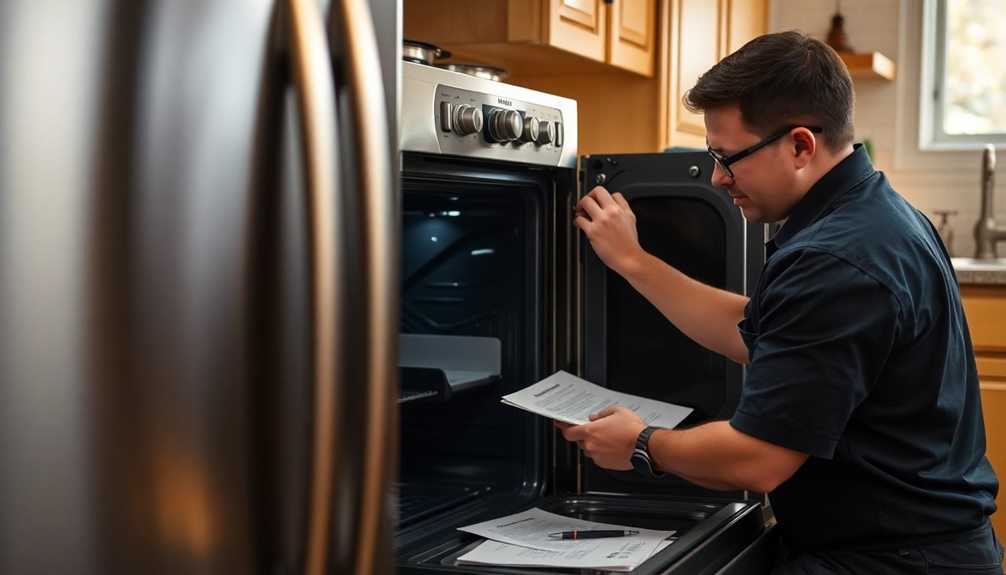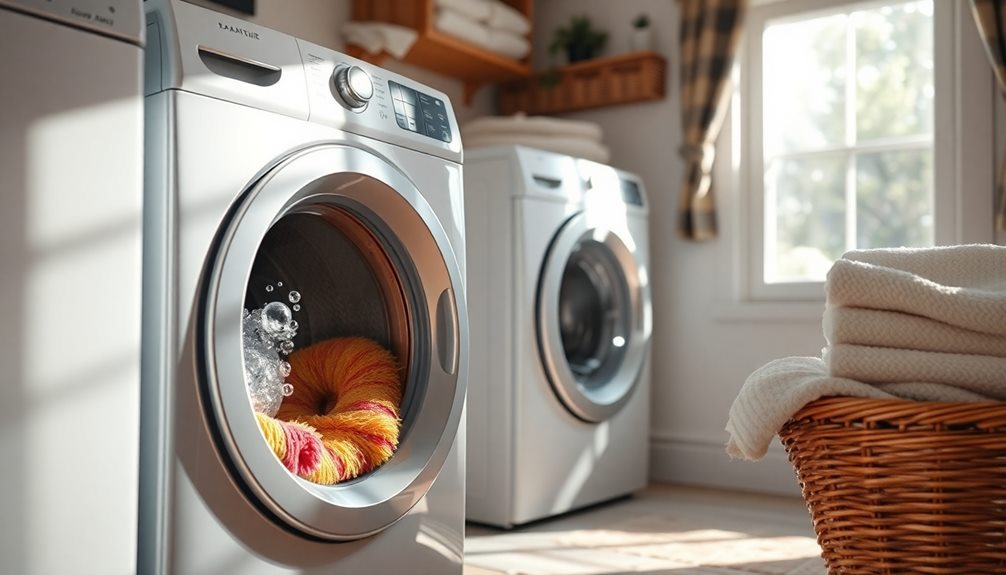To understand EnergyGuide labels on appliances, begin by reviewing the estimated annual operating cost. This number can help you plan your budget based on typical usage. Then, compare the energy consumption in kilowatt-hours (kWh) to determine how much energy the appliance uses in a year. Look for certifications such as ENERGY STAR, which indicate higher efficiency. Lastly, refer to the central comparison scale to assess how the appliance stacks up against similar models. By focusing on these important features, you will be able to make better choices that support your energy-saving objectives. Stay tuned for more tips on maximizing the efficiency of your appliances!
Key Takeaways
- Check the estimated annual operating cost to budget for potential energy expenses based on typical usage.
- Compare the energy consumption figures in kilowatt-hours (kWh) to assess efficiency among similar models.
- Use the central comparison scale to see how the appliance's energy use stacks up against others.
- Look for ENERGY STAR certification for assurance of higher energy efficiency and potential savings.
- Review appliance details like make, model, and capacity for informed purchasing decisions tailored to your needs.
Importance of EnergyGuide Labels
When shopping for new appliances, understanding the importance of EnergyGuide labels can make a significant difference in your decision-making process. These labels provide essential information on the estimated annual operating costs and energy consumption of appliances, helping you make informed choices.
Required by the Federal Trade Commission (FTC), EnergyGuide labels guarantee transparency, allowing you to compare energy efficiency across various models. Additionally, being aware of energy consumption patterns can help you identify which appliances contribute to higher bills.
By examining these labels, you can identify efficient appliances that might've higher upfront costs but lower long-term operating costs. This means you'll save money in the long run. The labels include a scale that compares the appliance's energy use with similar models, so you can easily spot which options are the most efficient.
Understanding EnergyGuide labels can lead to substantial savings on your energy bills, as appliances with lower operating costs contribute to overall financial benefits over time.
Investing in efficient appliances not only reduces your environmental impact but also enhances your home's energy efficiency. By prioritizing EnergyGuide information, you can guarantee that your appliance costs align with your budget and energy-saving goals.
Key Features of EnergyGuide Labels
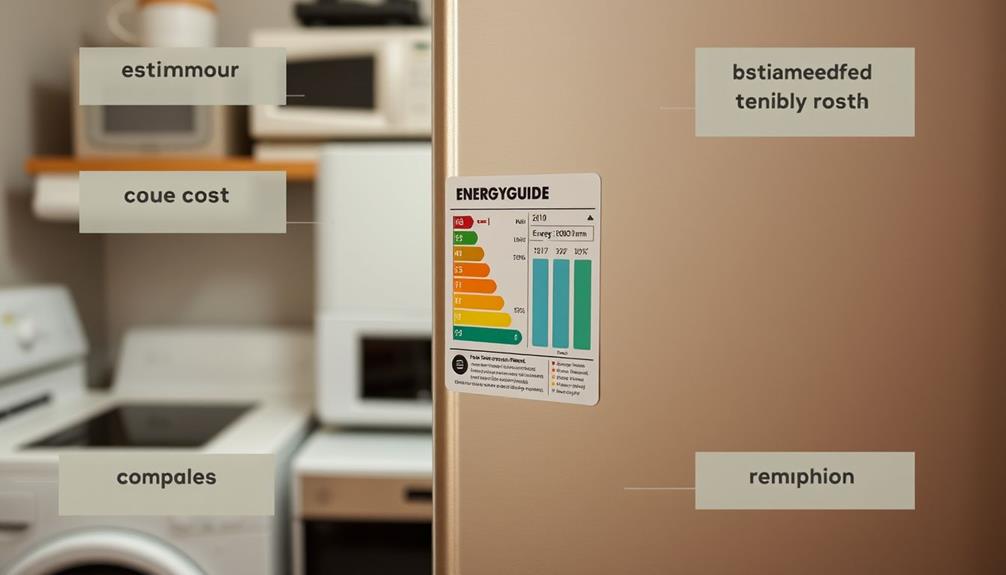
EnergyGuide labels are designed to provide you with key information that simplifies your appliance shopping experience. One of the most essential features is the estimated annual energy cost, which helps you gauge expected operating costs based on typical usage and national average energy prices. This figure allows you to plan your budget effectively.
Additionally, energy-efficient appliances, such as Ozone air purifiers, can greatly reduce your overall energy consumption.
The central scale on the label compares energy costs for similar appliance models, making it easier for you to identify energy-efficient products. You'll also find specific details like the make, model number, and capacity of the appliance, ensuring you can accurately compare options.
Additionally, the label provides the estimated annual electricity usage, giving you insight into how much energy the appliance is expected to consume throughout the year. This information is vital for understanding long-term energy consumption.
How to Read EnergyGuide Labels

When you look at an EnergyGuide label, you'll notice several key components that help you understand the appliance's efficiency.
Understanding the importance of energy efficiency is vital as it not only impacts your utility bills but also contributes to a more sustainable environment through reduced energy consumption, similar to how geothermal energy utilizes the earth's heat.
The estimated yearly energy cost and consumption figures allow you to compare different models easily.
Key Components Explained
Understanding the EnergyGuide label on appliances is essential for making informed choices about energy efficiency. This label provides crucial information that helps you assess the appliance's energy consumption and potential costs, similar to how one might evaluate the key factors in choosing a home cleaning service.
Here are the key components you should focus on:
- Estimated Yearly Energy Cost: This figure shows what you might spend annually on energy, based on typical usage and national average rates.
- Energy Consumption: Located in a box below the scale, this indicates the appliance's annual electrical usage in kilowatt-hours (kWh), helping you gauge its overall efficiency.
- Comparison Scale: The scale on the label allows you to compare the energy consumption of your appliance against similar models, guiding you to more efficient choices.
- Appliance Details: The upper section lists the appliance type, brand, model number, and capacity, ensuring you know exactly what you're considering.
Remember that individual usage patterns and local electricity rates can affect the actual costs, so use the EnergyGuide label as a starting point for understanding your potential energy expenses.
Cost Comparison Insights
As you evaluate appliances, comparing costs becomes essential for making a smart investment. EnergyGuide labels are your best tool for this, as they display estimated yearly operating costs based on typical usage and average national electricity prices. This feature allows for straightforward cost comparisons among similar models.
Understanding the importance of energy efficiency can also impact your long-term savings and environmental footprint, particularly when considering gout management strategies that advocate for mindful consumption.
On the label, you'll find a central scale indicating the appliance's energy efficiency relative to others. This helps you pinpoint more cost-effective options. Additionally, the label provides an estimated annual energy consumption figure, which can be invaluable in predicting your energy expenses according to your specific appliance usage.
Keep in mind that actual operating costs may differ based on local energy rates and your unique habits, so think of the label as a guideline rather than a fixed price.
To effectively compare appliances, focus on the estimated yearly costs and electricity usage displayed. This approach will help you make informed decisions tailored to your household needs and budget.
Ultimately, understanding these cost comparisons will empower you to choose the appliance that not only meets your needs but also saves you money over time.
Understanding Estimated Operating Costs
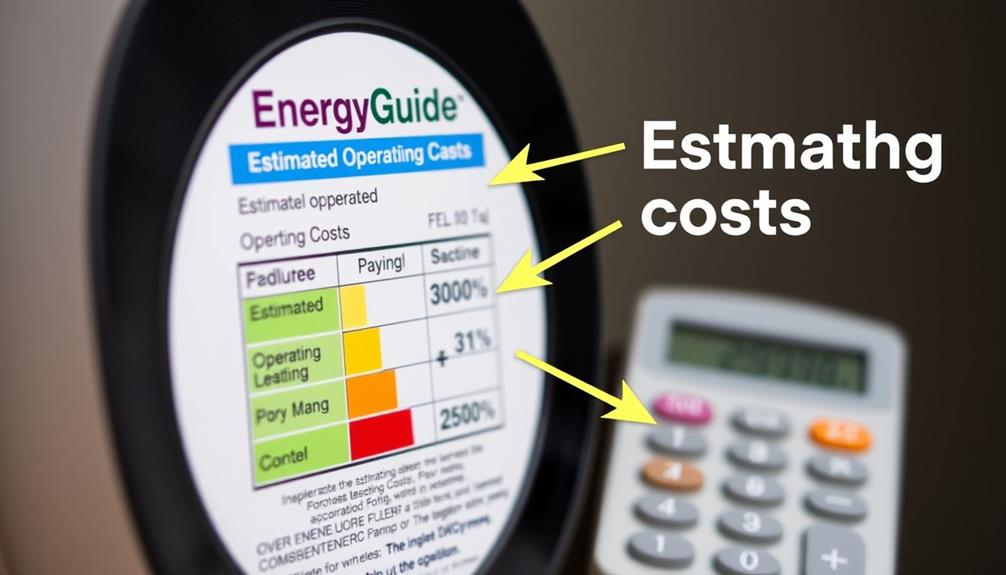
Typically, the estimated operating costs on EnergyGuide labels give you a clear picture of what to expect regarding yearly energy expenses for appliances. These costs are based on national average energy prices and typical usage patterns, providing a helpful guideline.
Implementing energy-efficient practices can also contribute to lowering these costs, just as effective strategies for weight management can lead to better overall health.
Here's what you should keep in mind:
- The label highlights the estimated yearly energy cost, reflecting anticipated spending for appliance operation.
- Actual costs can vary based on local energy prices, your usage habits, and household size.
- You can compare the estimated operating costs across similar models to identify more energy-efficient options.
- Understanding these figures helps you balance upfront costs with potential energy savings in the long run.
ENERGY STAR Certification Explained
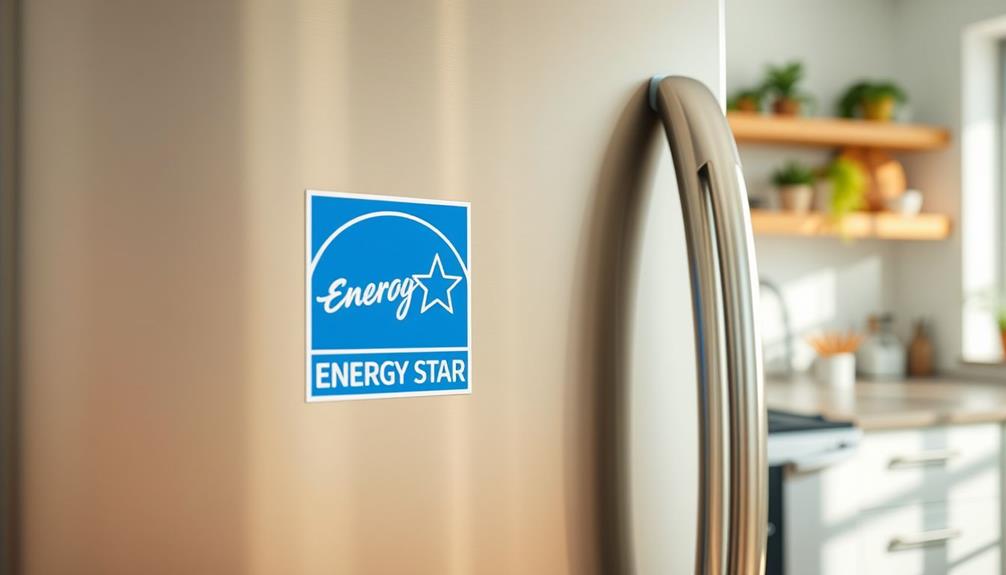
ENERGY STAR certification is your assurance that an appliance meets rigorous energy efficiency standards set by the Environmental Protection Agency (EPA). This certification often exceeds federal standards by at least 15%, helping you save energy and reduce your operating costs.
When you choose an ENERGY STAR certified appliance, you're also opting for reliability. Over 20 certification bodies and 500 laboratories independently verify these products, ensuring their energy claims are trustworthy. Plus, ENERGY STAR Most Efficient products represent the highest tier of efficiency, giving you even more savings compared to standard models.
Here's a quick overview of ENERGY STAR benefits:
| Feature | Description |
|---|---|
| Certification | Meets EPA's efficiency standards |
| Energy Use | Typically lower than non-certified models |
| Operating Costs | Reduced due to efficient energy consumption |
| Environmental Impact | Helps cut greenhouse gas emissions |
| Financial Incentives | Often qualifies for rebates from utility companies |
Benefits of Energy-Efficient Appliances

Investing in energy-efficient appliances can considerably reduce your energy bills while benefiting the environment.
Though these appliances may have a higher upfront cost, they often pay for themselves within a few years through significant savings on operating costs.
With the Energy Star logo and EnergyGuide labels, you can easily compare options and make informed decisions that align with your budget.
Additionally, just as diversifying your retirement portfolio with options like a Gold IRA can enhance financial security, selecting energy-efficient appliances can provide both financial and environmental benefits.
Here are some benefits of choosing energy-efficient appliances:
- Lower Utility Bills: These appliances can reduce your energy consumption by 10% to 50%, directly impacting your monthly expenses.
- Rebates and Incentives: Many utility companies offer cash rebates for ENERGY STAR certified appliances, providing additional savings.
- Long-Term Savings: Major appliances typically last around 10 years, so investing in energy-efficient models means substantial savings over time.
- Environmental Impact: By reducing your energy use, you're contributing to a smaller carbon footprint and helping protect the planet.
Choosing energy-efficient appliances not only helps you save money but also promotes a sustainable lifestyle.
Finding EnergyGuide Labels on Appliances
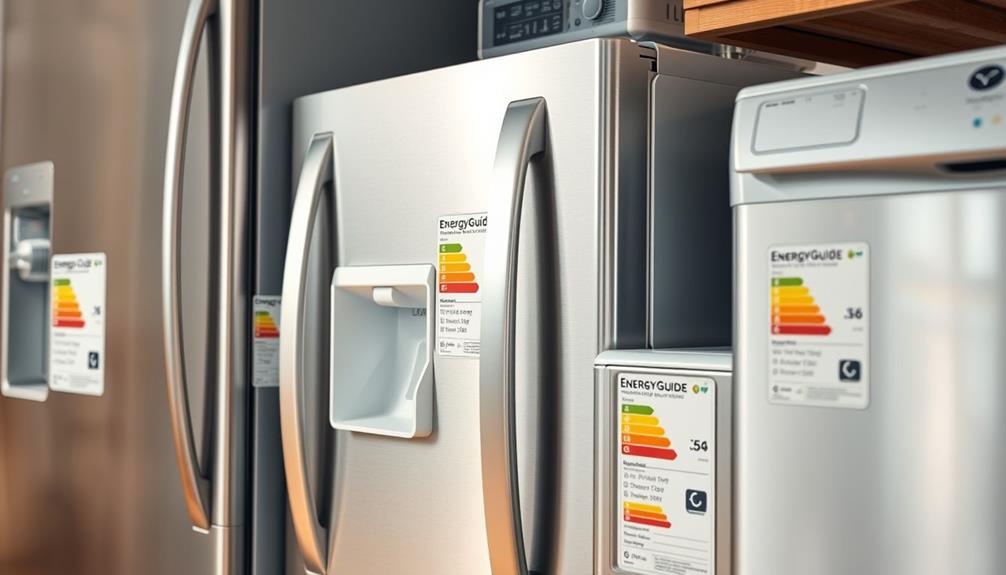
When you're ready to shop for energy-efficient appliances, knowing where to find EnergyGuide labels can make a big difference in your decision-making process. Typically, you'll find these labels on the front or side of appliances, guaranteeing they're easily visible for consumers like you. This visibility helps you quickly gather essential information about the appliance's energy consumption.
Understanding the impact of energy efficiency on your personal finances can also help you make more informed choices, as energy-efficient appliances can lead to long-term savings on utility bills and lessen your overall debt burden, similar to credit card trends.
If you can't spot the label right away, don't worry. Some manufacturers place it in less visible locations, like inside the appliance. Check there if needed.
For those shopping online, many manufacturers and sellers provide detailed information about EnergyGuide labels on their websites, allowing you to research before making a purchase.
If you still can't locate the EnergyGuide label, reaching out to customer service for the appliance brand can clarify its location. They can guide you to the right spot and help guarantee you're making an informed choice.
Being aware of where to find EnergyGuide labels is vital as it empowers you to choose energy-efficient appliances that can save you money and reduce your carbon footprint. Happy shopping!
Comparing Appliances Using EnergyGuide
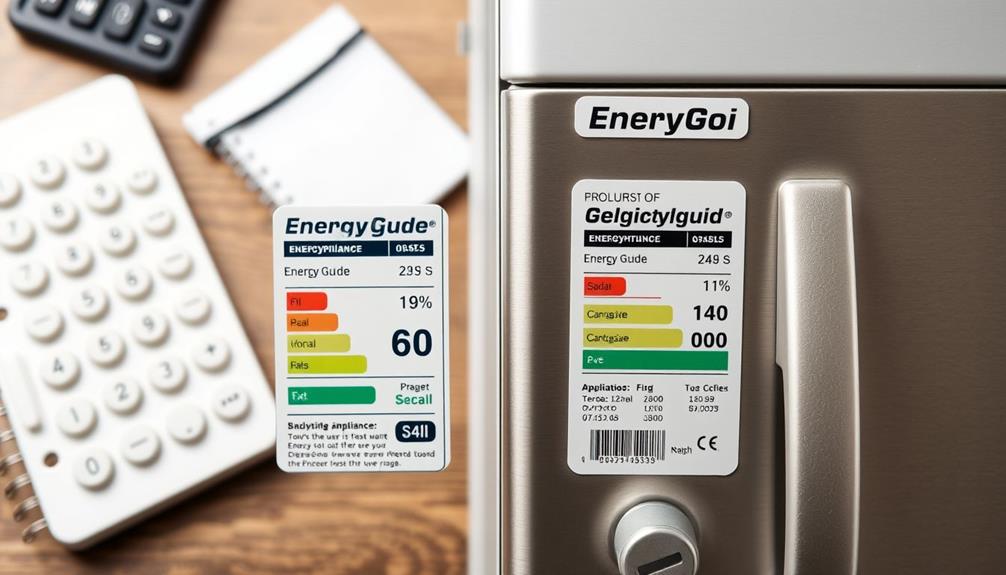
As you explore your options for new appliances, comparing their EnergyGuide labels can greatly impact your decision.
These labels provide valuable insights into each appliance's estimated annual energy costs and overall efficiency, helping you make informed choices.
Understanding clogging remedies can also help you select appliances that work well with your home's plumbing system.
When you compare appliances, focus on the following key aspects:
- Estimated annual electricity consumption in kilowatt-hours (kWh) allows for straightforward comparisons.
- The central scale on the label shows how a specific model's energy use stacks up against others.
- Pay attention to the range of operating costs, which indicates potential savings or expenses over time.
- Look for the ENERGY STAR label, as it signifies enhanced energy efficiency.
Energy Saving Tips for Homeowners
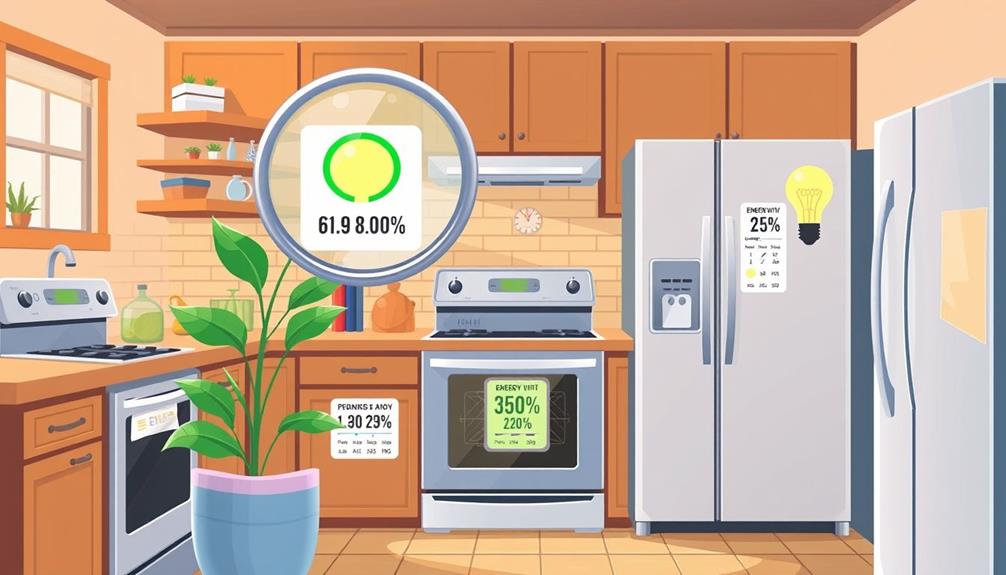
Understanding the EnergyGuide labels on appliances lays the groundwork for making energy-efficient choices, but there's more you can do to save on energy costs in your home.
Start by upgrading to ENERGY STAR certified appliances, which can reduce your operating costs by up to 30% compared to standard models. Consider investing in energy-efficient devices like garage door openers that enhance home security and offer smart features for remote access.
Regular maintenance of your HVAC system is equally essential; changing filters and scheduling annual check-ups can improve energy efficiency by 5-15% and extend the lifespan of your equipment.
Consider using smart power strips to combat phantom energy loss from devices in standby mode. This simple switch can save you up to $100 a year.
Don't forget to seal air leaks around windows and doors, which can cut heating and cooling costs by 10-20%.
Exploring Solar Panel Benefits
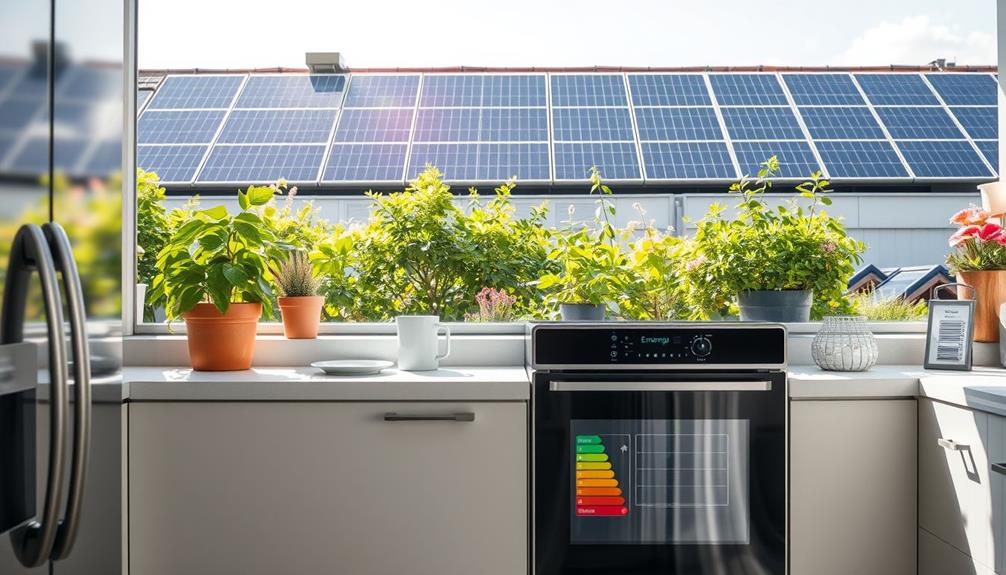
When you consider installing solar panels, you're not just looking at immediate costs; you're also eyeing the long-term savings on your electricity bills.
Plus, by choosing solar energy, you're making a positive impact on the environment by reducing carbon emissions.
It's an investment that pays off both in your wallet and for the planet.
Long-term Savings Potential
Many homeowners are discovering the long-term savings potential of solar panels, which can drastically cut electricity bills. By investing in solar energy, you're not just reducing your operating costs; you're also increasing your home's efficiency and value.
Consider these benefits:
- You can save an average of $1,500 annually, depending on energy costs and system size.
- With a payback period of 5 to 15 years, your initial investment starts paying off sooner than you might think.
- Federal tax credits and state-specific rebates can cover up to 26% of the installation cost.
- Homes with solar systems sell for about 4% more than similar homes without them.
When you look at the EnergyGuide labels, remember these savings. They're not just about immediate costs, but also long-term savings that can greatly impact your finances.
As you explore solar panel benefits, you'll find that investing in renewable energy is a smart financial decision. By making the switch, you're positioning yourself to save money while enhancing the value of your home for years to come.
Environmental Impact Considerations
Investing in solar panels not only benefits your wallet but also plays an essential role in protecting the environment. By reducing your reliance on fossil fuels, you contribute to lower greenhouse gas emissions, markedly helping to mitigate climate change.
Solar energy systems can drastically reduce your electric bill, with savings potentially reaching thousands of dollars over their lifespan. Moreover, many solar installations qualify for tax credits and rebates, enhancing their financial viability.
When you harness the power of the sun, you achieve energy independence—generating your own electricity and reducing vulnerability to fluctuating energy prices.
The average solar panel installation can offset around 100,000 pounds of carbon dioxide emissions over 30 years, making it a potent force for environmental sustainability. This aligns with the principles found on EnergyGuide labels, which help you understand the operating costs of major home appliances.
Frequently Asked Questions
How to Read Energyguide Label?
To read an EnergyGuide label, you'll want to check the estimated yearly energy cost first. Then, compare the model's efficiency and features against similar appliances to make an informed purchasing decision that fits your needs.
What Does an Energuide Label Tell You?
An EnergyGuide label tells you the estimated annual energy costs, yearly energy consumption in kilowatt-hours, and how the appliance compares to similar models. It helps you choose energy-efficient options for your home.
How to Read an Energy Consumption Label?
Did you know that the average household spends about $2,000 annually on energy? To read an energy consumption label, check the yearly cost, compare efficiency scales, and note the kWh usage to gauge potential expenses effectively.
How Do You Read an Appliance Label?
To read an appliance label, start by checking the estimated yearly energy cost and annual consumption in kilowatt-hours. Then, compare the appliance's efficiency against similar models using the scale provided for better understanding.
Conclusion
By understanding EnergyGuide labels, you empower yourself to make informed choices, balancing cost and efficiency. While one appliance may seem cheaper upfront, higher operating costs can drain your wallet over time. Juxtaposing initial price with long-term savings reveals the true value of your investment. As you explore energy-efficient options like ENERGY STAR products or even solar panels, remember that every choice you make today shapes a more sustainable tomorrow for both your finances and the planet.
